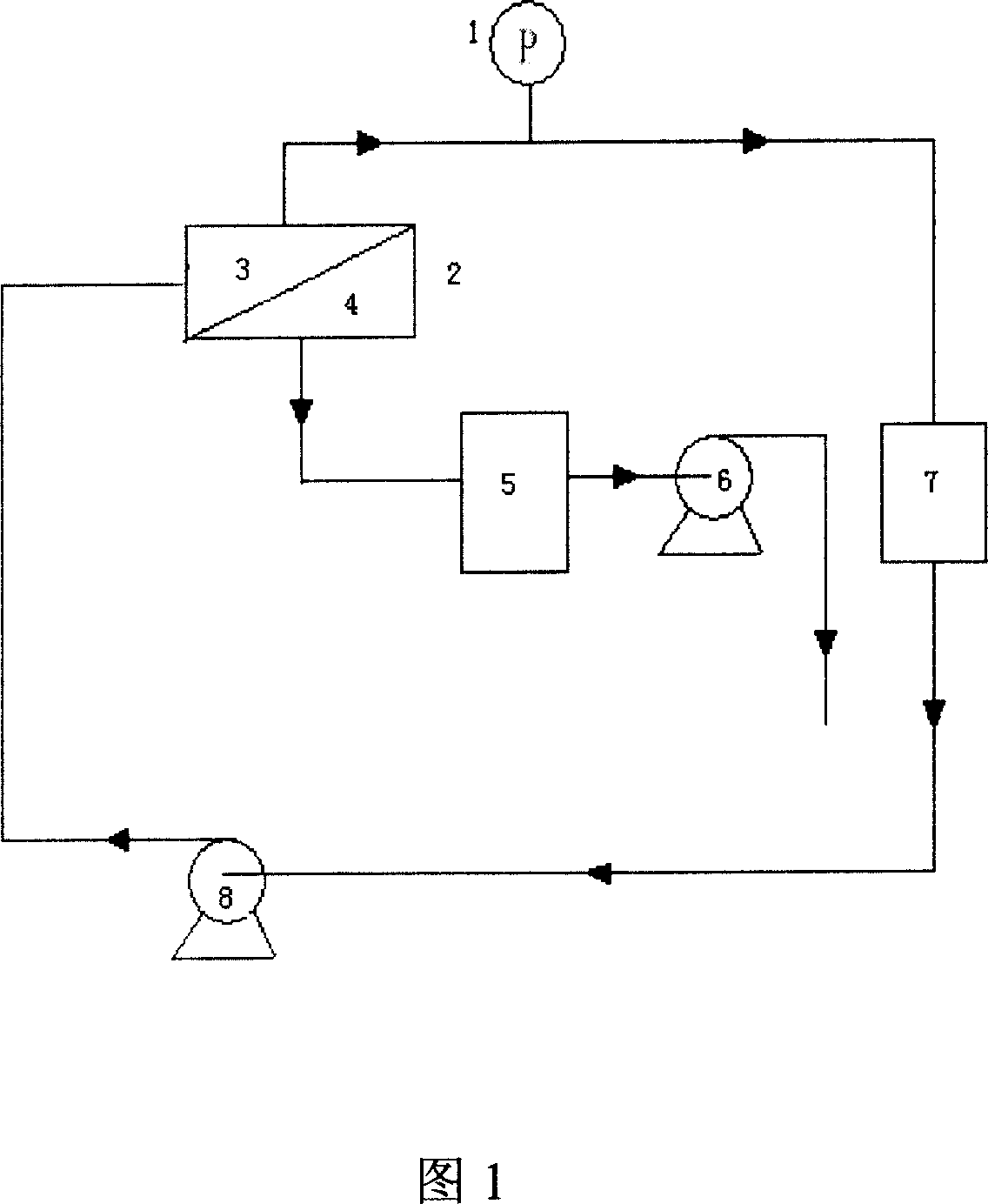Infiltration vaporization blending composite film for removing phenols from waste water
A pervaporation and composite membrane technology, applied in the field of pervaporation blended composite membranes, can solve the problems of limited adsorption capacity, complex process flow, secondary pollution, etc., achieve the best physical and chemical properties, expand the scope of use, and low production costs Effect
- Summary
- Abstract
- Description
- Claims
- Application Information
AI Technical Summary
Problems solved by technology
Method used
Image
Examples
Embodiment 1
[0036] Dissolve polyacrylonitrile in N,N-dimethylacetamide solvent to prepare a membrane solution with a concentration of 16% by mass. After filtration and deaeration, it is cast on a polyester non-woven fabric with a casting thickness of 160μm. , The polyacrylonitrile porous ultrafiltration base membrane is made by gel in water at 15℃.
[0037]Dissolve dimethyl silicone rubber (viscosity 10000Pa.s) with a mass percentage concentration of 70% and trifluoropropyl silicone rubber (viscosity 8000Pa.s) with a mass percentage concentration of 28% in the solvent n-heptane and stir to make it Fully dissolved. Then add the crosslinking agent ethyl orthosilicate with a concentration of 0.7% by mass, dibutyltin dilaurate with a concentration of 0.1% by mass and γ-glycidyl ether oxypropyl trimethoxysilane with a concentration of 1.2% by mass. , Prepare the blended membrane solution, continue to stir and react for a period of time, after filtering and degassing, set aside.
[0038] Treat the ...
Embodiment 2
[0042] Dissolve polyetherimide in N,N-dimethylacetamide solvent to prepare a membrane solution with a concentration of 16% by mass. After filtering and defoaming, it is cast on a polyester non-woven fabric, and the thickness is cast. It is 160μm and gelled in water at 15℃ to make polyetherimide porous ultrafiltration base membrane.
[0043] Dissolve dimethyl silicone rubber with a concentration of 25% by mass (viscosity 20000 Pa.s) and a trifluoropropyl silicone rubber with a concentration of 73% by mass (viscosity 10000 Pa.s) in the solvent n-heptane and stir to make it Fully dissolved. Then add the crosslinking agent ethyl orthosilicate with a concentration of 0.5% by mass, dibutyltin dilaurate with a concentration of 0.1% by mass and γ-glycidyl ether oxypropyl trimethoxysilane with a concentration of 1.4% by mass. , Prepare the blended membrane solution, continue to stir and react for a period of time, after filtering and degassing, set aside.
[0044] Treat the polyetherimide ...
Embodiment 3
[0048] Dissolve polyacrylonitrile in N,N-dimethylacetamide solvent to prepare a membrane solution with a concentration of 18% by mass. After filtration and deaeration, it is cast on a polyester non-woven fabric with a casting thickness of 160μm. , The polyacrylonitrile porous ultrafiltration base membrane is made into polyacrylonitrile porous ultrafiltration membrane by gel in water at 15℃.
[0049] Dissolve dimethyl silicone rubber with a mass percentage concentration of 45% (viscosity 10000 Pa.s) and a trifluoropropyl silicone rubber with a mass percentage concentration of 52.7% (viscosity 8000 Pa.s) in the solvent n-heptane and stir to make it Fully dissolved. Then add the crosslinking agent ethyl orthosilicate with a concentration of 0.75% by mass, dibutyltin dilaurate with a concentration of 0.05% by mass, and γ-glycidyl ether oxypropyl trimethoxysilane with a concentration of 1.5% by mass. , Prepare the blended membrane solution, continue to stir and react for a period of ti...
PUM
| Property | Measurement | Unit |
|---|---|---|
| Thickness | aaaaa | aaaaa |
| Thickness | aaaaa | aaaaa |
| Thickness | aaaaa | aaaaa |
Abstract
Description
Claims
Application Information
 Login to View More
Login to View More - R&D
- Intellectual Property
- Life Sciences
- Materials
- Tech Scout
- Unparalleled Data Quality
- Higher Quality Content
- 60% Fewer Hallucinations
Browse by: Latest US Patents, China's latest patents, Technical Efficacy Thesaurus, Application Domain, Technology Topic, Popular Technical Reports.
© 2025 PatSnap. All rights reserved.Legal|Privacy policy|Modern Slavery Act Transparency Statement|Sitemap|About US| Contact US: help@patsnap.com

